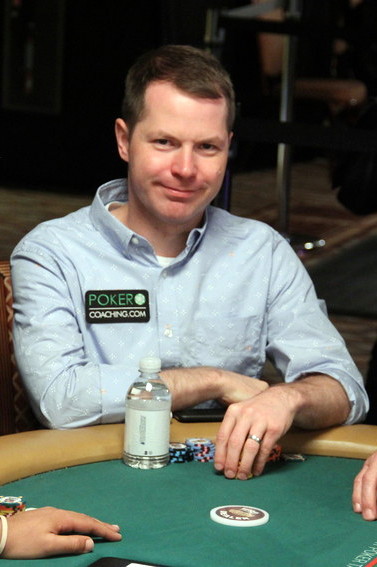






Bluff Catching On A Four-Flush Boardby Jonathan Little | Published: Aug 25, 2021 |
|
|

Jonathan Little
The following hand came up in one of the $10,000 buy-in events, with blinds at 500-1,000 with a 1,000 big blind ante. I raised to 2,500 out of my 125,000 effective stack with Q J
J from the cutoff seat. A younger, but good European player called in the small blind, and a tighter player called from the big blind.
from the cutoff seat. A younger, but good European player called in the small blind, and a tighter player called from the big blind.
The flop came K 10
10 4
4 , giving me an open-ended straight draw on a three-flush board. My opponents checked to me.
, giving me an open-ended straight draw on a three-flush board. My opponents checked to me.
On this board, it is somewhat likely that one of my opponents has either a pair or a draw that will not fold to a continuation bet, and I do not especially want to get check-raised off my junky draw.
Note that when good players call from the small blind, they usually have a range containing lots of strong, but non-premium big cards, which connect well with the king and ten on the flop. Since I will have decent equity if I improve to either a pair or a straight, and I may be able to win on the turn or river with a bluff, checking makes sense.
I checked. The turn was the Q , giving me second pair, and my opponents again checked to me. At this point, I likely have the best hand, but I do not want to allow a club or jack to come on the river that could easily give one of my opponents a better hand.
, giving me second pair, and my opponents again checked to me. At this point, I likely have the best hand, but I do not want to allow a club or jack to come on the river that could easily give one of my opponents a better hand.
I decided to bet 4,500 into the 8,500 pot, and only the small blind called. The river was the 6 , putting four clubs on the board. To my surprise, the small blind led for 10,000 into the 17,500 pot.
, putting four clubs on the board. To my surprise, the small blind led for 10,000 into the 17,500 pot.
This would be an easy fold against most players because I lose to any flush, but it is important to consider how this strong opponent would perceive my range. When I check behind on the flop, my opponent will probably presume I do not have the A or a flush because I would have bet those. If I do not have the nuts or a decent flush, that drastically decreases the number of hands I can easily call with on the river.
or a flush because I would have bet those. If I do not have the nuts or a decent flush, that drastically decreases the number of hands I can easily call with on the river.
It is also worth noting that my opponent may bet the turn with the A , perhaps removing some of those combinations from his range. I was not sure if he would value bet with the Q
, perhaps removing some of those combinations from his range. I was not sure if he would value bet with the Q or J
or J , although it is possible. In general, most players will not value bet with marginal flushes in this spot because they will typically only get called when they are beat, or perhaps by one of the few weaker flushes in my range. My opponent could also be turning a hand better than mine, such as K
, although it is possible. In general, most players will not value bet with marginal flushes in this spot because they will typically only get called when they are beat, or perhaps by one of the few weaker flushes in my range. My opponent could also be turning a hand better than mine, such as K 9
9 , into a bluff.
, into a bluff.
The idea that neither of us has the nut flush made me think that my opponent would be bluffing much more often than normal, looking to put me in a tough spot with hands weaker than a flush.
Given my pot odds, which dictate that I need to have the best hand 27% of the time to justify calling, 10,000 ÷ (10,000 + 10,000 + 17,500), I decided to call.
While I am unsure exactly how often I have the best hand, I am sure I will win more than 27% of the time against a crafty player who is more than capable of making a move. Luckily for me, my opponent turned over J 10
10 for a worse made hand turned into a bluff, awarding me the pot.
for a worse made hand turned into a bluff, awarding me the pot.
While I did not fare too well in this particular event, I was fortunate to take fourth place in the $50,000 buy-in main event, cashing for $231,000. ♠
 Jonathan Little is a two-time WPT champion with more than $7 million in live tournament earnings, best-selling author of 15 educational poker books, and 2019 GPI Poker Personality of the Year. If you want to increase your poker skills and learn to crush the games, check out his training site at PokerCoaching.com/cardplayer.
Jonathan Little is a two-time WPT champion with more than $7 million in live tournament earnings, best-selling author of 15 educational poker books, and 2019 GPI Poker Personality of the Year. If you want to increase your poker skills and learn to crush the games, check out his training site at PokerCoaching.com/cardplayer.
Features
The Inside Straight
Strategies & Analysis